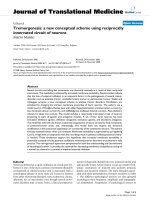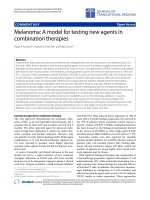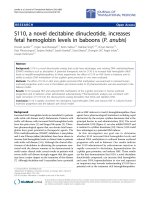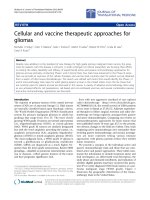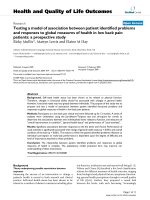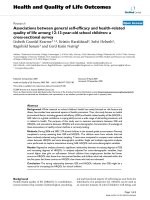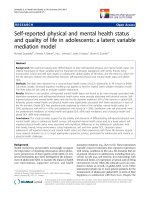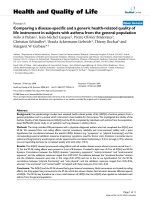báo cáo hóa học:" Tremorgenesis: a new conceptual scheme using reciprocally innervated circuit of neurons" pptx
Bạn đang xem bản rút gọn của tài liệu. Xem và tải ngay bản đầy đủ của tài liệu tại đây (416.95 KB, 6 trang )
BioMed Central
Page 1 of 6
(page number not for citation purposes)
Journal of Translational Medicine
Open Access
Editorial
Tremorgenesis: a new conceptual scheme using reciprocally
innervated circuit of neurons
Mario Manto
Address: FNRS ULB Erasme, 808 Route de Lennik, 1070 Bruxelles, Belgium
Email: Mario Manto -
Abstract
Neural circuits controlling fast movements are inherently unsteady as a result of their reciprocal
innervation. This instability is enhanced by increased membrane excitability. Recent studies indicate
that the loss of external inhibition is an important factor in the pathogenesis of several tremor
disorders such as essential tremor, cerebellar kinetic tremor or parkinsonian tremor. Shaikh and
colleagues propose a new conceptual scheme to analyze tremor disorders. Oscillations are
simulated by changing the intrinsic membrane properties of burst neurons. The authors use a
model neuron of Hodgkin-Huxley type with added hyperpolarization activated cation current (I
h
),
low threshold calcium current (I
t
), and GABA/glycine mediated chloride currents. Post-inhibitory
rebound is taken into account. The model includes a reciprocally innervated circuit of neurons
projecting to pairs of agonist and antagonist muscles. A set of four burst neurons has been
simulated: inhibitory agonist, inhibitory antagonist, excitatory agonist, and excitatory antagonist.
The model fits well with the known anatomical organization of neural circuits for limb movements
in premotor/motor areas, and, interestingly, this model does not require any structural
modification in the anatomical organization or connectivity of the constituent neurons. The authors
simulate essential tremor when I
h
is increased. Membrane excitability is augmented by up-regulating
I
h
and I
t
. A high level of congruence with the recordings made in patients exhibiting essential tremor
is reached. These simulations support the hypothesis that increased membrane excitability in
potentially unsteady circuits generate oscillations mimicking tremor disorders encountered in daily
practice. This new approach opens new perspectives for both the understanding and the treatment
of neurological tremor. It provides the rationale for decreasing membrane excitability by acting on
a normal ion channel in a context of impaired external inhibition.
Editorial
Tremor is defined as a rapid oscillation of a body part [1].
Tremor is one of the most common movement disorders
encountered in clinical practice and is associated with a
neurological disease in most cases [2]. Tremor is distinct
from other movement disorders, such as dystonia, chorea,
athetosis, tics or myoclonus, even though several move-
ment disorders may co-exist. From a clinical perspective,
tremor is classically divided into rest, postural, kinetic and
task-specific forms. Action tremor occurs as a result of vol-
untary contraction of muscles and includes postural,
kinetic and isometric tremors. The main disorders associ-
ated with these presentations of tremor are given in Table
1. The different pathological tremors are also grouped
according to their frequency, amplitude and topographi-
cal distribution. Frequencies of pathological tremor in
Published: 26 November 2008
Journal of Translational Medicine 2008, 6:71 doi:10.1186/1479-5876-6-71
Received: 24 November 2008
Accepted: 26 November 2008
This article is available from: />© 2008 Manto; licensee BioMed Central Ltd.
This is an Open Access article distributed under the terms of the Creative Commons Attribution License ( />),
which permits unrestricted use, distribution, and reproduction in any medium, provided the original work is properly cited.
Journal of Translational Medicine 2008, 6:71 />Page 2 of 6
(page number not for citation purposes)
upper limbs range from 3 to 9 Hz in the majority of cases.
Tremor disorders are a cause of social difficulties in many
patients, impairing numerous activities of daily life.
About 25 % of patients do not respond to drugs or neuro-
surgical therapies. One of the reasons is our lack of under-
standing in the pathogenesis and natural history of several
tremor disorders.
Current theories suggest that tremor is driven by complex
combinations of mechanical reflex and central neurogenic
oscillations. These oscillations are superimposed on a
background of irregular fluctuations in muscle force and
limb displacements [3]. In tremors originating in the cen-
tral nervous system, generators are relatively insensitive to
peripheral perturbations in most cases. The mechanical
reflex component is dependent upon the inertial and elas-
tic properties of the body [4]. The frequency of passive
mechanical oscillations ω depends upon the stiffness K
and is inversely related to the inertia I, according to the
following equation:
ω = (K/I)
1/2
Several brain areas play a key-role in tremorgenesis (Fig-
ure 1). These regions are the main elements of critical
loops controlling voluntary and involuntary motor com-
mands. Each of these loops has specific anatomical con-
nections, inherent time delays, adaptable gains and
interacts with a myriad of sensory feedback signals [5]:
-the loop between motor cortex and basal ganglia
-the loop between the cerebellum and the brainstem,
especially the Guillain-Mollaret triangle, which links den-
tate nucleus of the cerebellum with the contralateral red
nucleus and the inferior olive (this loop is also called the
dentate-rubro-olivary tract)
-the loop between the cerebellum, the thalamic nuclei and
the motor cortex (cerebello-thalamo-cortical pathway and
cortico-ponto-cerebellar tracts)
-the peripheral loops, including the afferences from the
muscle spindles to the alpha-motoneurons (spinal loop)
and from the peripheral sensors to the motor cortex
(transcortical loop). The stretch reflex depends on mono-
synaptic connections between primary afferent fibers and
motor neurons. Spindles also inhibit motor neurons to
antagonist muscles through Ia inhibitory interneurons.
Afferent fibers from Golgi tendon organs provide a nega-
tive feedback for regulating tension via Ib inhibitory
interneurons.
Pathological Tremor is usually rhythmic. However,
tremor is a non linear and non stationary phenomenon
[6]. These last 3 decades, tremor time-series have been
mainly analyzed using simultaneous recordings of elec-
tromyographic (EMG) activity and acceleration signals,
generally measured with piezoresistive accelerometers.
Table 2 summarizes the main techniques to assess tremor.
Currently, the power spectral analysis is still the most
applied tool for neurological disorders manifesting with
tremor. Power spectral density (PSD) allows the extrac-
Table 1: Main neurological disorders associated with tremor
Type of tremor Diseases
Rest tremor Parkinson's disease
"Parkinson-plus" syndromes
Drug-induced Parkinsonism
Stroke
Post-traumatic tremor
Psychogenic tremor
Postural tremor Essential Tremor
Enhanced Physiological tremor
Cerebellar ataxias
Multiple Sclerosis
Post-traumatic tremor
Drug-induced postural tremor
Metabolic diseases
Psychogenic tremor
Kinetic tremor ("intention tremor") Cerebellar ataxias
Essential Tremor
Multiple Sclerosis
Psychogenic tremor
Task-specific Primary writing tremor
Dystonic tremor
Isometric tremor Primary and secondary orthostatic tremor*
*Might overlap with essential tremor.
Journal of Translational Medicine 2008, 6:71 />Page 3 of 6
(page number not for citation purposes)
Illustration of the main anatomical pathways implicated in tremorFigure 1
Illustration of the main anatomical pathways implicated in tremor. Abbreviations: UMN: upper motor neurons pro-
jecting to anterior horn in spinal cord, BG: basal ganglia, stn: subthalamic nucleus, sn: substantia nigra, RN: red nucleus, IO: infe-
rior olivary complex, mf: mossy fibers, cf: climbing fibers, Ia: spindle afferents, MNγ: gamma-motoneuron, MNα: alpha-
motoneuron. MN pool: motoneuronal pool.
Journal of Translational Medicine 2008, 6:71 />Page 4 of 6
(page number not for citation purposes)
tion of the distribution of power. Various parameters
indicative of the intensity and variability of tremor are
computed, such as centre frequency, frequency dispersion
or harmonic index, which help to distinguish pathologi-
cal tremors [1]. In addition, cross-spectral analysis investi-
gates the interactions and dependencies between several
signals, with extraction of phase and coherency spectra. In
order to study the roles of specific brain areas in tremor
generation, cross-spectral analysis has also been applied
between EMG data, electroencephalographic signals
(EEG), neuronal discharges in deep brain nuclei, magne-
toencephalography (MEG), and other biomedical meas-
urements. Wavelet transforms have also been used
effectively for non-stationary signals such as tremor,
including for denoising procedures given their advantages
as compared to conventional filtering like smoothing.
However, all these techniques have shown limits. Current
tools have not allowed the grasping of the activity of the
brain networks at a cellular level. In addition, there is still
a lack of knowledge regarding the neurochemical events
occurring at the beginning or throughout the course of
tremor disorders. Surprisingly, several drugs currently
administered for the management of tremor have been
assessed in human in absence of identification of their
mechanism of regulation of neuronal discharges related
to tremor. For instance, it is unclear how primidone -
which is widely administered for essential tremor- affects
the neurophysiological and neurochemical properties of
brain networks involved in tremor genesis. The effects of
the main neurotransmitters implicated (GABA, glutamate,
acetylcholine, serotonin, nitric oxide) on the behaviour of
central and peripheral oscillators are very complex. This
complexity seems even greater when the heterogeneity of
the intrinsic properties of each network and the multiple
reciprocal connections are taken into account. The trans-
lation of the neuronal discharges generated centrally into
oscillatory activities in peripheral effectors cannot be
understood without attempting to extract the rules gov-
erning these elemental neurochemical events. Another
factor which has hampered the research in tremor disor-
ders is the difficulty in translating data from animal mod-
els, especially from rodent models of tremor [7]. This is
the case for instance with the model of acute administra-
tion of harmaline in rodents [8], widely used to mimic
essential tremor, or for the animal models of Parkinson's
disease [9,10]. Despite the fact that 6-hydroxydopamine
(6-OHDA) and MPTP (1-methyl-4-phenyl-1,2,3,4-tet-
rahydropyridine) are very useful for analyzing the mecha-
nisms of dopaminergic neuron degeneration, no
remarkable rest tremor similar to parkinsonian tremor is
induced by these neurotoxins [7]. They cannot be
regarded as a valid model of rest tremor. Trying to isolate
mechanisms of tremor from four-footed animals and to
extrapolate them to human beings is not straight-forward.
Developments of convenient and reproducible methods
of evaluation of tremor are needed.
It is currently assumed that most kinds of tremor are asso-
ciated with an overexcitability of neurons, rendering the
neurons prone to discharge in a rhythmic way. Therefore
the initial events leading to an increase of excitability
deserve attention. Several drugs reducing neuronal mem-
brane excitability improve tremor. This is typically the
case with propranolol, GABA-mimetic inhibitory agents
such as gabapentin or topiramate, or ethanol. These drugs
affect the balance between GABA and glutamate.
In this issue, Shaikh and colleagues propose a new con-
ceptual scheme to analyze tremor disorders [11]. They
propose a scheme based on the Sherrington's principle for
reciprocal innervation and the phenomenon of post-
inhibitory rebound (PIR), which is the rebound increase
in firing rates of neurons when the inhibition is removed.
These 2 properties render some networks prone to oscilla-
tions [12,13]. The authors point out that oscillations in
reciprocally innervated circuits appear if the relative effect
Table 2: Clinical and experimental techniques to evaluate tremor
Tool Parameter analyzed
Clinical scales Clinical scores of disability
Videos Clinical characterization of tremor
Quantification of drawings Evaluation of tremor in 2 dimensions
Surface and needle EMG studies Assessment of muscle discharges and motor units
Goniometers Position/displacement
Gyroscopes Rotational motion
Accelerometers Acceleration signal
Electromagnetic sensors Changes in magnetic field
Optoelectronic devices Position in 3 dimensions
Haptic/Myohaptic devices Force
Textiles integrating position sensors Displacement/rotation
Biomechanical modelling Interactions torques
Neural networks Simulation of neural circuits
Journal of Translational Medicine 2008, 6:71 />Page 5 of 6
(page number not for citation purposes)
of intact external inhibition is reduced by an increased
excitability within the reciprocally innervated neurons
themselves. In other words, increased neural excitability
can overcome the effects of normal external inhibition.
Increased excitability could result from an increase in
either the hyperpolarization activated cation current (I
h
,
related to HCN1–HCN4) or the low threshold calcium
current (I
t
, related to CaV3 channels) [14,15], or altera-
tions in the intracellular levels of second messengers and
the regulators modulating the activation kinetics of these
ion channels. Shaikh et al. have tested their hypothesis by
simulating a Hodgkin-Huxley type, conductance-based
model of pre-motor burst neurons responsible for ballis-
tic limb movements. The authors hypothesize that
increased membrane excitability in pre-motor neurons
has a key role in pathogenesis of disorders like essential
tremor. The circuit consists of reciprocally innervating
excitatory neurons and reciprocally inhibiting inhibitory
neurons, and includes physiologically-realistic membrane
kinetics of the premotor neurons determined by subsets
of membrane ion channels. The latter also determines the
excitability of the membrane. By increasing specific mem-
brane conductances that are known to increase PIR and
neural excitability, such as I
h
and I
t
, they could simulate
the range of frequencies of tremor recorded from patients.
The increase in these currents resulted in alternating
bursts of action potentials in the neurons innervating the
sets of agonist and antagonist muscles. The frequency of
the simulated tremor was very close to the actual tremor
frequency recorded in human.
One of the consequences of this model is the following:
interfering with the function of a normal ion channel to
decrease membrane excitability in case of impaired exter-
nal inhibition might reduce the oscillatory behaviour.
This might have a special interest for circuits in the thala-
mus, inferior olive, cerebrum and cerebellum, given their
electrophysiological properties and their patterns of
innervation. Indeed, these structures are particularly
prone to spontaneous or triggered oscillations. Thalamo-
cortical firing patterns vary with their membrane poten-
tial, and thalamic neurons might behave as oscillators or
even resonators [16]. The interaction between cation cur-
rents and calcium conductance may generate oscillations
from 0.5 to 4 Hz. Animal studies in models of Parkinson's
disease suggest that neuronal oscillations are spontane-
ously generated within the basal ganglia system, especially
the pallidum and the subthalamic nucleus, but are mainly
synchronized by cortical activity via the striatal inputs.
There is an abnormal coupling between the EMG of fore-
arm muscles and the activity in the contralateral primary
motor cortex at tremor frequency in this common neuro-
degenerative disorder [17]. In essential tremor, a bilateral
overactivity of cerebellar connections is strongly sus-
pected, with increased synchronous discharges in the
olivocerebellar tracts and overall disinhibition of cerebel-
lar nuclei. These latter receive their inputs from the
Purkinje cells and are the sole output of the cerebellar cir-
cuitry. Predictive computations and rhythmicity in senso-
rimotor networks are impaired in case of cerebellar lesion
[18]. Rhythmicity includes the regular recurrence of
events within the information flow, as one can expect in
tremor disorders. It is interesting to underline that cere-
bellar patients present errors in the tuning and timing of
activation of agonist and antagonist muscle, as well as
motor learning deficits [19,20].
Tremor is attracting the attention of scientists from vari-
ous disciplines, because of the high prevalence of neuro-
logical disorders associated with tremor and thanks to the
progress made these last years in terms of better character-
ization of neurological disorders, mainly with brain imag-
ing (Magnetic Resonance Imaging, Positron Emission
Tomography) and molecular biology techniques. The
model presented here brings new insights into mecha-
nisms of tremor disorders and also opens direct and short-
term perspectives in terms of treatment evaluation. The
similarities with the recordings made in patients are out-
standing. Furthermore, this model might serve in the
future for the deciphering of motor commands and neural
representations of movement, the so-called 'internal mod-
els' which now encompass not only motor but also cogni-
tive operations [21]. In this sense, this approach would
have broader applications in translational medicine.
References
1. Grimaldi G, Manto M: Tremor: from pathogenesis to treat-
ment. Morgan and Claypool; 2008.
2. Bhidayasiri R: Differential diagnosis of common tremor syn-
dromes. Postgr Med J 2005, 81:756-762.
3. Elble RJ: Characteristics of physiologic tremor in young and
elderly adults. Clin Neurophysiol 2003, 114(4):624-35.
4. Elble RJ: Central mechanism of tremor. J Clin Neurophysiol 1996,
13:133-144.
5. Manto M, Bastian AJ: Cerebellum and the deciphering of motor
coding. Cerebellum 2007, 6:3-6.
6. Boose A, Spieker S, Jentgens C, Dichgans J: Wrist tremor: Investi-
gation of agonist-antagonist interaction by means of long-
term EMG recording and cross-spectral analysis. Electroen-
cephalogr Clin Neurophysiol – Electromyogr Motor Control 1996,
101:355-363.
7. Miwa H: Rodent models of tremor. Cerebellum 2007, 61:66-72.
8. Miwa H, Kubo T, Suzuki A, Kihira T, Kondo T: A species-specific
difference in the effects of harmaline on the rodent olivocer-
ebellar system. Brain Res 2006, 10681:94-101.
9. Wang G, Fowler SC: Concurrent quantification of tremor and
depression of locomotor activity induced in rats by harma-
line and physostigmine. Psychopharmacology (Berl) 2001,
1583:273-80.
10. Hattori N, Sato S: Animal models of Parkinson's disease: simi-
larities and differences between the disease and models.
Neuropathology 2007, 275:479-83.
11. Shaikh AG, Kiura K, Optican LM, Ramat S, Tripp RM, Zee DS: Hypo-
thetical membrane mechanisms in essential tremor. J Transl
Med 2008, 6(1):68.
12. Ramat S, Leigh RJ, Zee DS, Optican LM: Ocular oscillations gener-
ated by coupling of brainstem excitatory and inhibitory sac-
cadic burst neurons. Exp Brain Res 2005, 160(1):89-106.
13. Shaikh AG, Miura K, Optican LM, Ramat S, Leigh RJ, Zee DS: A new
familial disease of saccadic oscillations and limb tremor pro-
Publish with Bio Med Central and every
scientist can read your work free of charge
"BioMed Central will be the most significant development for
disseminating the results of biomedical researc h in our lifetime."
Sir Paul Nurse, Cancer Research UK
Your research papers will be:
available free of charge to the entire biomedical community
peer reviewed and published immediately upon acceptance
cited in PubMed and archived on PubMed Central
yours — you keep the copyright
Submit your manuscript here:
/>BioMedcentral
Journal of Translational Medicine 2008, 6:71 />Page 6 of 6
(page number not for citation purposes)
vides clues to mechanisms of common tremor disorders.
Brain 2007, 130(Pt 11):3020-31.
14. McCormick DA, Pape HC: Properties of a hyperpolarization-
activated cation current and its role in rhythmic oscillation
in thalamic relay neurones. J Physiol 1990, 431:291-318.
15. Shaikh AG, Finlayson PG: Excitability of auditory brainstem
neurons, in vivo, is increased by cyclic-AMP. Hear Res 2005,
201(1–2):70-80.
16. Llinás RR, Paré D: Of dreaming and wakefulness. Neuroscience
1991, 44(3):521-35.
17. Timmermann L, Gross J, Dirks M, Volkmann J, Freund HJ, Schnitzler
A: The cerebral oscillatory network of parkinsonian resting
tremor. Brain 2003, 126(Pt 1):199-212.
18. Molinari M, Leggio MG, Thaut MH: The cerebellum and neural
networks for rhythmic sensorimotor representation in the
human brain. Cerebellum 2007, 6:18-23.
19. Diener HC, Dichgans J: Pathophysiology of cerebellar ataxia.
Mov Disord 1992, 7:95-109.
20. Ito M: Mechanisms of motor learning in the cerebellum. Brain
Res 2000, 886:237-245.
21. Kawato M: Internal models for motor control and trajectory
planning. Curr Opin Neurobiol 1999, 9:718-727.

